Author: Sheridan Bartlett
In today’s urbanising world, we are rapidly losing the green spaces that are so vital to our health and well-being. Here, I share some especially compelling research on the benefits of these spaces and the costs of doing without them, particularly for children. These findings date back to the mid-1990s. Yet they continue to provide a powerful rationale for making equitable access to the natural environment an integral feature of urban development.
The loss of urban green spaces
When the 17th century poet Marvell wrote ‘a green thought in a green shade’ to describe the transcendental beauty of nature in his poem The Garden, he could hardly have imagined the rapidly urbanising world that we live in today. And yet the importance of access to green space that he describes – and its myriad benefits – is just as relevant today as it was 400 years ago.
In the journal I co-edit, Environment and Urbanization, a recent submission documents the disappearance of 80% of the green space in Kumasi in Ghana since 1991.[i] This trend is not unusual in rapidly urbanising Africa or elsewhere in our densifying urban fabric worldwide. In many cities in the global South, as populations grow, the quantity and quality of green space is plummeting.[ii] As the demand for land increases, it is not surprising that natural areas should be encroached upon and developed, both legally and illegally.
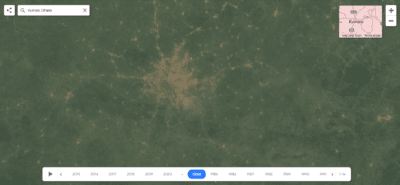
Kumasi in 1984. Google Earth

Kumasi in 2020. Google Earth
For instance, only 2.5% of Mumbai’s area currently consists of public green space and only 2.2% of Istanbul or of Mexico City. But it’s not impossible for urban growth and vegetation to co-exist, even in densely built-up urban areas. Consider Singapore with 45%, or more surprisingly, Moscow with 54%.[iii] It’s a matter of smart planning and political will. These very attributes, unfortunately, are in short supply in much of our urbanising world.
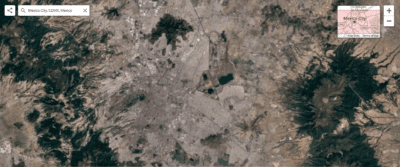
Mexico City in 2020. Google Earth
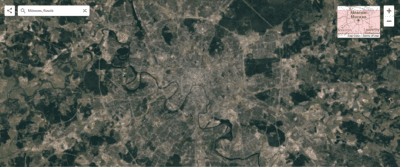
Moscow in 2020. Google Earth.
Nor is it a surprise that what green space there is should be inequitably distributed. Low-income neighbourhoods, often the most crowded, are most often the least well served with trees and parks.[iv] When land is in short supply, housing, basic services and space for livelihoods inevitably take priority. Even in peripheral low-income settlements, where there may still be unmanaged areas of greenery or even well-tended market gardens among the dumps and drosscape[v] of our urban edges, it is only a matter of time. When every inch of land begins to be used and contested, vegetation seldom takes precedence.
Urban children crave green space
It is hardly newsworthy that trees and accessible green space are critically important to urban children and their families. Our intuitive recognition of this is backed up by a growing body of work demonstrating the significance of this relationship. In the 1990s, the journal Landscape and Urban Planning published twelve papers on this topic. In the last decade, this number grew to 276.[vi]
But don’t rely just on the scientists and scholars. When urban children all over the world are asked what they value most in their surroundings, they almost always talk about trees and natural areas. Back in the 1970s, urban planner Kevin Lynch published his classic work, Growing up in Cities. He documented the longing of children in cities in Argentina, Mexico, Poland and Australia for trees and green space.[vii]
And as recently as this summer (June 2021), studies from places as varied as Angola and Argentina reported on the deep attachment of urban children to natural surroundings.[viii] Even in the aftermath of the tsunami in 2004, while adults in Tamil Nadu and Sri Lanka focused on the urgent need for new housing, the children I spoke to thought tree planting should come first – life would stay too hard and too sad, they said, in a baked landscape with no shade.
The myriad benefits of green space
What are the benefits exactly? They are numerous and far reaching. Vegetation improves air quality and it reduces heat – both critical functions in our warming world.[ix] Studies from multiple locations have noted the far-reaching effects for human health.[x] A longstanding literature from the global North points to the restorative quality of nature in the face of noisy, crowded urban surroundings and the chronic mental fatigue that can accompany life in these stressful environments.[xi] In the global South, the research is starting to catch up. In slums in Lima and Bengalaru for instance, trees, gardens and even potted plants have been noted to boost social capital and general well-being.[xii]
For children specifically, there are many well-established benefits for health and development on all fronts.[xiii] In recent years, these findings have been supported by a growing body of research from the global South. In Delhi for instance, trees and vegetation have been associated with lower stress levels in children.[xiv] In Kathmandu, distance to green space is found to be the most significant factor influencing obesity and overweight in children.[xv] In Iran, research relates exposure to green space for preschool children to the length of their telomeres (part of our DNA) – a marker, arguably, for stress and longevity.[xvi]
Green vs barren spaces: the Chicago experiment
No research I know of comes close to being as persuasive and compelling as a series of studies from some public housing projects in Chicago in the USA, undertaken over 20 years ago.[xvii] Frances Kuo, William Sullivan and their colleagues were able to take advantage of a lucky coincidence here to explore the effects of proximity to vegetation. When the low-income Ida B Wells housing blocks were built in the 1940s, the open spaces between them were landscaped with trees and grass. In some cases, the plantings took root and flourished, and there were areas with groves of shady trees. In other cases, the open spaces gradually deteriorated into barren stretches, or the trees were pulled out for maintenance reasons and the ground was paved over.
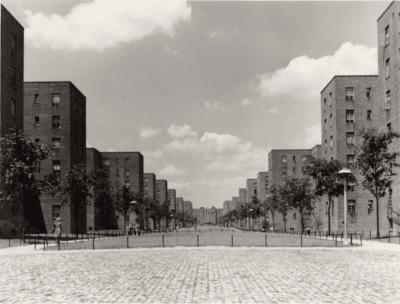
Ida B. Wells Housing Project – Museum Purchase, 2003
Kuo and Sullivan began their research in the mid-1990s, in what was then rated as one of the 12 poorest neighbourhoods in the country. Because the residents of these housing blocks had been randomly assigned to their buildings, the situation was in effect a natural controlled experiment. Kuo and Sullivan were able to compare people in urban poverty living in buildings with trees to those in identical buildings with more desolate surroundings. In neither case did residents have any control over the maintenance of the grounds around their buildings, so their involvement was not a factor.
Over the next several years, Kuo and Sullivan found some remarkable differences. What was most immediately apparent was that trees drew people outside – 83% more people socialised in the green spaces at Ida B Wells than in the treeless spaces. Building managers and police had predicted that people would be more fearful in the areas with trees. But in fact they reported feeling safer there.[xviii] Residents in the buildings with trees were found to be significantly more outgoing, more likely to know their neighbours and more likely to experience social support.
There was a generally higher sense of well-being in these buildings, and a better capacity to function. Residents reported less procrastination in facing the difficult issues in their lives. They perceived these challenges as being less severe, less longstanding and easier to solve than did their counterparts living in the other buildings.[xix] The stronger social bonds were associated with fewer reports of either violent crime or property crime, less aggression and lower rates of domestic violence in the green buildings. Residents from buildings with trees generally reported using less violent ways of dealing with conflict, including with their children.[xx] Frances Kuo provided the following summary: ‘Just as rats and other laboratory animals housed in unfit environments undergo systematic breakdowns in healthy, positive patterns of social functioning, so too do people.’[xxi]
The effects were notable for children as well, beyond the fact that they were less likely to face violence from the adults in their lives. Children from the greener buildings were twice as likely to play outdoors as children from the barren buildings, and their play was more imaginative and creative – they invented new jump rope routines, they made up stories. They also had more contact with adults (probably because the adults were more likely to be around) and the interactions were more constructive.[xxii] The children from the green buildings had significantly fewer symptoms of attention deficit hyperactivity disorder (ADHD), and parents rated them as better able to follow directions, resist distractions and focus on tasks.[xxiii] Even a view of trees and vegetation from inside their apartments made a difference, accounting for instance for 20% of the variance in girls’ scores for self-discipline.[xxiv]
Green space: how can cities provide equitable access?
Trees and natural surroundings are far from being a frivolous amenity. They are a fundamental component of an adequate environment for children and their families, neglected at our peril. A surprising thing to keep in mind is the fact that the differences revealed in the Chicago research, although highly significant in both statistical and social terms, did not stem from radical differences in the surroundings. The greener buildings were not graced by acres of lush groves and gardens. It was generally a matter of a few mature trees that had managed to survive. Well-kept parks, gardens and areas of natural wilderness are precious assets in any urban landscape, and should be available to all residents. But just as important, perhaps, is the sight of greenery outside the window of an overcrowded apartment, or a shady tree outside the door or a place to sit with neighbours and watch children play.
Cities can promote equitable access to the benefits of urban green space. Making this an integral feature of urban development requires a supportive framework of policy and legislation. Access to funding is essential, and this calls in turn for a clear understanding of the multiple benefits of green infrastructure – not only the direct benefits for human beings, but also the economic, ecological and climate resilience benefits. As with so many aspects of equitable urban development, it requires respect and support for inclusive community-led planning and management, ensuring as Mell and Whitten put it in their discussion of financing and equitability, that green infrastructure will be ‘accessible, meaningful and functional for local populations.’[xxv]
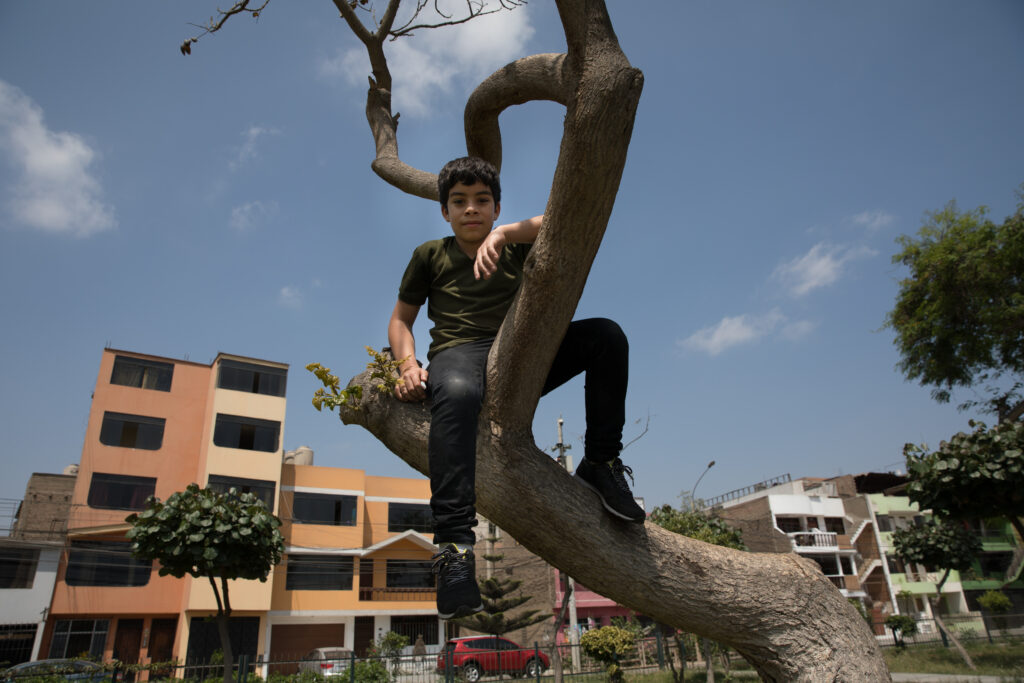
Hanna Adcock Save the Children
Further reading
Some interesting resources on prioritising, protecting and promoting inclusive urban green space:
- Asian Coalition for Housing Rights (2020) Four community vegetable gardens. ACHR news and updates. achr.net/news-detail.php?id=42
- Bagotlo, O (27 July 2021) We also want greens in our meals: community gardens in the Philippines. IIED blog. https://bit.ly/2XRyHjs
- Boonmahathanakorn, S (3 December 2020) Rubbish dump turned lush urban farm. IIED blog. https://bit.ly/3kAOZpC
- Cities Alliance, Myanmar: local solutions for mitigating extreme heat, youtube.com/watch?v=rozhCfu_Rgk
- CODI (undated) This national program helps urban poor communities grow and produce healthy food right in their settlements. https://bit.ly/3Ai6kIY
- Kyama, R (4 July 2016) Kenyan school children’s environment project. Africa Leadership Initiative. https://bit.ly/3zL4pvP
- Mell, I and Whitten, M (2021) Access to nature in a post COVID-19 world: opportunities for green infrastructure financing, distribution and equitability in urban planning. International Journal of Environmental Research and Public Health 18(4). https://bit.ly/3kz7avF
- Odero, JO (11 February 2020) Planting pilot has vision to nurture young tree ambassadors. IIED blog. https://bit.ly/3hVSYLu
- Shanahan, M (8 December 2011) Postcard from Durban: greener football and tree-preneurs. IIED blog. https://bit.ly/3o1BiSG
About the Author
Sheridan Bartlett is a research associate at the Children’s Environments Research group at City University in New York (CERG) and co-editor of the journal Environment and Urbanization. She works primarily in the area of early childhood education and on issues affecting children in the context of urban poverty in low income countries, attempting to bridge the gaps between the work of child-focused agencies and the broader development context.
Endnotes
[i] Cobbinah, PB and Nyame, V (2021) A city on the edge: the political ecology of urban green space in Kumasi. Environment and Urbanization 33(2).
[ii] Nero, BF (2017) Urban green space dynamics and socio-environmental inequity: multi-resolution and spatiotemporal data analysis of Kumasi, Ghana. International Journal of Remote Sensing 38(23): 6,993–7,020.
[iii] World Cities Culture Forum, % of public green space (parks and gardens), www.worldcitiescultureforum.com/data/of-public-green-space-parks-and-gardens
[iv] Mitchell, BC, Chakraborty, J and Basu, P (2021) Social inequities in urban heat and greenspace: analyzing climate justice in Delhi, India. International Journal of Environmental Research and Public Health 18(9): 4,800.
[v] Drosscape refers to ‘waste landscapes’ within urbanised areas that are the waste product of defunct economic and industrial processes. See Berger, A (2006) Drosscape: wasting land in urban America. Abebooks.
[vi] Zhang, J, Yu, Z, Zhao, B, Sun, R and Vejre, H (2020) Links between green space and public health: a bibliometric review of global research trends and future prospects from 1901 to 2019. Environmental research letters 15(6), 063001.
[vii] Lynch, K (Ed) (1977) Growing up in cities: Studies of the spatial environment of adolescence in Cracow, Melbourne, Mexico City, Salta, Toluca, and Warszawa. MIT press.
[viii] Pedrosa, E L J, Okyere, S A, Frimpong, L K, Diko, S K, Commodore, T S and Kita, M (2021) Planning for informal urban green spaces in African cities: children’s perception and use in peri-urban areas of Luanda, Angola. Urban Science 5(3): 50; Faggi, A, Madanes, N, Villa, V D, Eisenreich, S and Breuste, J (2021) Present and future perception of urban and suburban riverscapes from drawings made by children and adolescents. Interdisciplinary Journal of Environmental and Science Education 17(2), e2235.
[ix] McDonald, R, Kroeger, T, Boucher, T, Wang, L and Salem, R (2016) Planting healthy air: a global analysis of the role of urban trees in addressing particulate matter pollution and extreme heat. US Climate Resilience Toolkit. https://bit.ly/39w92PG; Al-Saadi, LM, Jaber, SH and Al-Jiboori, M H (2020) Variation of urban vegetation cover and its impact on minimum and maximum heat islands. Urban Climate 34: 100,707.
[x] Kondo, MC, Fluehr, JM, McKeon, T and Branas, CC (2018) Urban green space and its impact on human health. International Journal of Environmental Research and Public Health 15(3): 445; Wolf, KL, Lam, ST, McKeen, JK, Richardson, GR, van den Bosch, M and Bardekjian, AC (2020) Urban trees and human health: a scoping review. International Journal of Environmental Research and Public Health 17(12): 4,371.
[xi] Kaplan, S (1995) The restorative benefits of nature: toward an integrative framework. Journal of Environmental Psychology 15(3): 169–182; Joye, Y and van den Berg, AE (2018) Restorative environments. Environmental Psychology: an introduction, 65–75.
[xii] Korn, A, Bolton, SM, Spencer, B, Alarcon, JA, Andrews, L and Voss, JG (2018) Physical and mental health impacts of household gardens in an urban slum in Lima, Peru. International Journal of Environmental Research and Public Health 15(8): 1,751; Gopal, D and Nagendra, H (2014) Vegetation in Bangalore’s slums: boosting livelihoods, well-being and social capital. Sustainability 6(5): 2,459–2,473.
[xiii] Chawla, L (2015) Benefits of nature contact for children. Journal of Planning Literature 30(4): 433–452; Gill, T (2014) The benefits of children’s engagement with nature: a systematic literature review. Children Youth and Environments 24(2): 10–34; Moore, RC (1997) The need for nature: a childhood right. Social Justice 24(3: 69): 203–220; Wells, NM (2000) At home with nature: effects of “greenness” on children’s cognitive functioning. Environment and Behavior 32(6): 775–795; Mygind, L, Kurtzhals, M, Nowell, C, Melby, PS, Stevenson, MP, Nieuwenhuijsen, M, Lum, JAG, Flensborg-Madsen, T, Bentsen, P and Enticott, PG (2021) Landscapes of becoming social: a systematic review of evidence for associations and pathways between interactions with nature and socioemotional development in children. Environment International 146: 106,238.
[xiv] Bloemsma, LD, Wijga, AH, Klompmaker, JO, Hoek, G, Janssen, NA, Oldenwening, M, Koppelman, GH, Lebret, E, BRunekreed, B and Gehring, U (2021) Green space, air pollution, traffic noise and saliva cortisol in children: the PIAMA study. Environmental Epidemiology 5(2).
[xv] Manandhar, S, Suksaroj, TT and Rattanapan, C (2019) The association between green space and the prevalence of overweight/obesity among primary school children. The International Journal of Occupational and Environmental Medicine 10(1): 1.
[xvi] Miri, M, de Prado-Bert, P, Alahabadi, A, Najafi, M L, Rad, A, Moslem, A, Aval, HE, Ehrampoush, MH, Bustamante, M, Sakhvidi, MJZ, Nawrot, T, Sunyer, J and Dadvand, P (2020) Association of greenspace exposure with telomere length in preschool children. Environmental Pollution 266(1): 115,228.
[xvii] These studies include, among others: Kuo, FE, Sullivan, WC, Coley, RL and Brunson, L (1998) Fertile ground for community: inner-city neighborhood common spaces. American Journal of Community Psychology 26(6): 823–851; Kuo, FE and Sullivan, WC (2001) Aggression and violence in the inner city: effects of environment via mental fatigue. Environment and Behavior 33(4): 543–571; Kuo, FE (Ming) (2010) Parks and other green environments: essential components of a healthy human habitat. Research Series 2020, National Recreation and Park Association; Sullivan, WC, Kuo, FE and Depooter, SF (2004) The fruit of urban nature: vital neighborhood spaces. Environment and Behavior 36(5): 678–700.
[xviii] Kuo, FE, Bacaicoa, M and Sullivan, WC (1998) Transforming inner-city landscapes: trees, sense of safety, and preference. Environment and Behavior 30(1): 28–59.
[xix] Kuo, FE (2001) Coping with poverty: impacts of environment and attention in the inner city. Environment and Behavior 33(1): 5–34.
[xx] Prow, T (1999) The power of trees. Reprinted from The Illinois Steward 7(4) with permission. http://lhhl.illinois.edu/media/thepoweroftrees.htm
[xxi] Kuo, FE (2011) Parks and other green environments: ‘essential components of a healthy human habitat’. Australasian Parks and Leisure 14(1): 10–12.
[xxii] Taylor, AF, Wiley, A, Kuo, FE and Sullivan, WC (1998) Growing up in the inner city: green spaces as places to grow. Environment and Behavior 30(1): 3–27.
[xxiii] Taylor, AF, Kuo, FE and Sullivan, WC (2001) Coping with ADD: the surprising connection to green play settings. Environment and Behavior 33(1): 54–77.
[xxiv] Taylor, AF, Kuo, FE and Sullivan, WC (2002) Views of nature and self-discipline: evidence from inner city children. Journal of Environmental Psychology 22(1-2): 49–63.
[xxv] Mell, I and Whitten, M (2021) Access to nature in a post COVID-19 world: opportunities for green infrastructure financing, distribution and equitability in urban planning. International Journal of Environmental Research and Public Health 18(4): 1,527.
Note: This article presents the views of the author featured and does not necessarily represent the views of Global Alliance – Cities 4 Children as a whole

This work is licensed under a Creative Commons Attribution-NonCommercial-NoDerivatives 4.0 International License.

